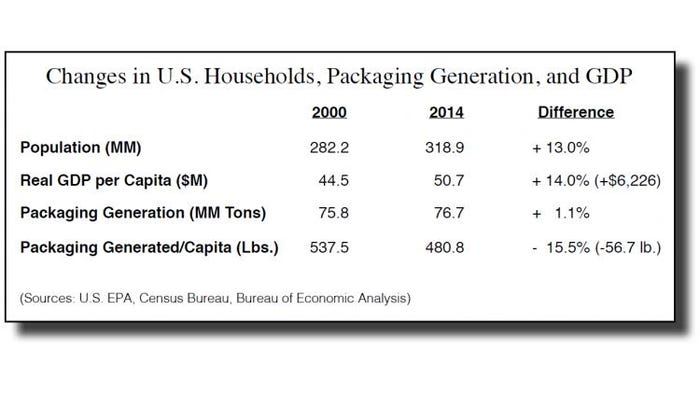Surprise! We’re trashing less packaging now
More people on the planet. More products being sold. But Americans are throwing away less packaging today than they did more than a decade ago. How can that be? Eco-packaging expert Bob Lilienfeld does the math for us.
In the September 2017 The ULS (Use Less Stuff) Report, editor and publisher Bob Lilienfeld tells us “10 Things I Bet You Didn’t Know About Packaging”—the first of which is that “We’re throwing away less packaging today than we did 15 years ago.”
He looks at population growth and gross domestic product (GDP) to calculate the data that backs up his claim. “Between 2000 and 2014, the amount of packaging thrown away grew by only 1.1%. This is impressive, given that the U.S. population grew by 13.0%, and real (inflation adjusted) per capita GDP grew by 14.0% during this same period.
“These statistics mean that productivity per person increased over $6,000, while the amount of packaging needed to do so declined by almost 57 pounds.
“Thus, more goods (and services) are being produced with less packaging.”

Certainly a focus on sustainability, especially in this past decade, has helped. But where was the greatest gain? “The primary strategy for achieving this very positive result has been source reduction(the first ‘R’ in reduce, reuse and recycle)—needing less packaging to deliver the same or a larger amount of products,” Lilienfeld writes.
He concludes, “And, when it comes to minimizing greenhouse gas (GHG) emissions, the primary environmental focus by nations large and small, source reduction is the best way to do so. After all, it’s better to not use materials and energy than to figure out how to reduce the effects of doing so.”
Download a free copy of the September 2017 The ULS Report below to read about his other nine surprising facts:
#2. Packaging can actually save resources.
#3. Your favorite products won’t make it home without packaging.
#4. Most rigid plastic packaging can be recycled.
#5. Even juice boxes and plastic grocery sacks can now be recycled.
#6. Compostable packaging may not actually reduce waste.
#7. Even if not recycled, packaging plays a positive environmental role.
#8. E-commerce packaging serves a valuable purpose.
#9. Packaging can actually reduce food waste.
#10. There are better ways to reduce waste than to simply ban certain packages.
******************************************************************
See a host of new ideas in packaging machinery, materials and more at MinnPack 2017 (Nov. 8-9; Minneapolis). Register today!
About the Author(s)
You May Also Like




